
Key Takeaways:
Revolutionizing Warehouse Operations: The Rapid Rise of Robots in Today’s Workforce
The Impact of Robots on Warehouse Operations
Robots have become a critical component in modern warehouse operations. With their ability to automate various tasks, robots have revolutionized the way warehouses function, leading to significant improvements in efficiency, productivity, and overall profitability. The rapid rise of robots in today’s workforce highlights the need for businesses to embrace automation in order to stay competitive in an increasingly digitized world.
The Benefits of Robotic Automation
The integration of robots into warehouse operations offers several key benefits. Firstly, robots can perform repetitive tasks more quickly and accurately than humans, thus minimizing errors and improving overall productivity. With robots handling mundane activities such as packaging, sorting, and inventory management, human workers can focus on higher-value tasks that require problem-solving, critical thinking, and creativity.
Moreover, robots can work around the clock without any breaks or fatigue, thereby maximizing operational efficiency. This non-stop productivity allows warehouses to meet ever-increasing customer demands and reduce delivery times, resulting in improved customer satisfaction. Additionally, robots can easily adapt to changing demands and handle seasonal fluctuations, ensuring warehouses remain agile and responsive.
The efficiency and consistency provided by robots also contribute to cost savings in the long run. By reducing errors and optimizing the use of warehouse space, businesses can minimize unnecessary expenses and streamline their operations. Notably, robotic automation often leads to significant energy savings, as robots are designed to be energy-efficient and can operate under controlled conditions.
The Role of Artificial Intelligence in Warehouse Robotics
Artificial Intelligence (AI) plays an integral part in the development and advancement of warehouse robotics. Through machine learning algorithms, AI enables robots to constantly learn and improve their tasks and decision-making abilities. By analyzing large amounts of data, robots can optimize warehouse workflows, predict inventory needs, and even detect anomalies or potential risks.
Incorporating AI-powered robots into warehouse operations allows for greater adaptability and customization. These intelligent robots can adjust their performance to meet specific requirements, leading to enhanced accuracy and flexibility. As a result, businesses can optimize their inventory management, reduce wastage, and improve overall supply chain operations.
The Challenges of Implementing Warehouse Robotics
Although the benefits of incorporating robots into warehouse operations are clear, there are challenges to consider when implementing robotic automation.
Cost and Return on Investment (ROI) Analysis
The initial investment required to introduce robotic automation may be relatively high, which can deter some businesses from pursuing this technology. However, it is crucial to conduct a thorough cost analysis and understand the long-term benefits to accurately assess the potential return on investment. In many cases, the cost savings achieved through improved efficiency and reduced labor costs justify the upfront expenses of implementing warehouse robotics.
Workforce Adaptation and Collaboration
Integrating robots into the existing workforce also requires careful adjustments and effective change management. Employees may initially worry about the impact of robots on job security. To alleviate these concerns, businesses should emphasize how robotic automation can enhance their productivity and provide new opportunities for professional development. By fostering collaboration between humans and robots, businesses can create a harmonious work environment that maximizes the strengths of both parties.
Maintenance and Training
Robots, like any other equipment, require regular maintenance and occasional repairs. It is essential for businesses to establish comprehensive maintenance protocols and ensure that employees are properly trained to handle robotic systems. Continuous training programs can equip workers with the necessary skills to operate, program, and troubleshoot robotic systems effectively.
The Future of Robotic Warehouse Operations
The rapid rise of robots in today’s workforce indicates that the integration of robotic automation in warehouse operations will only continue to grow in the future. As technology advances, robots will become even more capable of performing complex tasks, adapting to dynamic environments, and collaborating seamlessly with humans. The emergence of Internet of Things (IoT) technologies and autonomous vehicles will further augment the capabilities of robots, allowing for more interconnected and efficient warehouse operations.
Robots have revolutionized the way warehouses function, through their efficient and reliable automation technologies. Their ability to enhance productivity and reduce costs has made them invaluable assets in modern warehouse operations. To maintain a competitive edge, it is imperative for businesses to embrace the rapid rise of robots in today’s workforce.
Frequently Asked Questions
Conclusion
In conclusion, the rapid rise of robots in today’s workforce is revolutionizing warehouse operations. The integration of robots offers numerous benefits, including improved efficiency, productivity, and cost savings. With the advancements in artificial intelligence, robots are becoming more intelligent, adaptable, and capable of collaborating with humans. However, businesses must carefully consider the challenges associated with implementing robotic automation, such as the initial investment and the need for workforce adaptation. By embracing the rapid rise of robots and strategically implementing robotic automation, businesses can transform their warehouse operations and maintain a competitive edge in an increasingly automated world.
Source: insidertechno.com